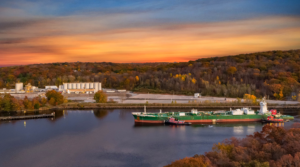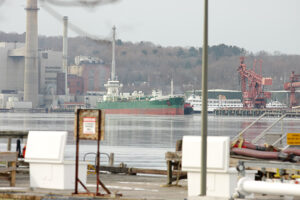
 It’s always a strange thing to find a place that carries your name…especially when your name is unusual. I haven’t found such a place for myself, but rather for my sister, Allyn Hadlock. As a matter of fact, there are places that carry both her first and her last name. The first I heard of was Port Hadlock, and the second is Allyn’s Point. Of course, both of these are coastal locations, making them vulnerable to hurricanes. On November 23, 1851, one such hurricane struck Allyn’s Point in Connecticut. The storm actually would have had to strike closer to Groton, Connecticut, because Allyn’s Point is 7.5 miles inland. Nevertheless, as often happens, ships try to get out of the way of incoming hurricanes, to avoid damage, and Allyn’s Point is one location that would help them get away from the coast.
It’s always a strange thing to find a place that carries your name…especially when your name is unusual. I haven’t found such a place for myself, but rather for my sister, Allyn Hadlock. As a matter of fact, there are places that carry both her first and her last name. The first I heard of was Port Hadlock, and the second is Allyn’s Point. Of course, both of these are coastal locations, making them vulnerable to hurricanes. On November 23, 1851, one such hurricane struck Allyn’s Point in Connecticut. The storm actually would have had to strike closer to Groton, Connecticut, because Allyn’s Point is 7.5 miles inland. Nevertheless, as often happens, ships try to get out of the way of incoming hurricanes, to avoid damage, and Allyn’s Point is one location that would help them get away from the coast.
The storm that hit the Sound on that fateful Friday was intense. Hurricane-force winds, torrential rain, and high seas were reported. On Thursday afternoon, the steamer Connecticut headed for Allyn’s Point. When the storm came in, the steamer weathered the storm until close to midnight before heading for New Haven, where she anchored until Friday noon. The Connecticut finally arrived at Allyn’s Point at 4:30pm that day. Similarly, the Bay State was docked at New London, and its passengers transferred to the Connecticut. Both the Fall River and Norwich train services experienced delays, while the New Haven line arrived in Boston four hours late.
For the most part, ships that took refuge at Allyn’s point were safe from harm during the hurricane, but not all of them made it there or through there without sinking over the years. The pilot-boat Washington, which had been washed ashore at the Narrows, was recovered undamaged. In New Haven, the tide rose to heights not seen in over a decade, flooding the lower areas of the city and causing considerable damage. Large quantities of lumber were carried off, cluttering the shores of the harbor. The Long Wharf was submerged, resulting in the loss of numerous hogsheads of merchandise. Worcester saw three inches of snow, which was quickly washed away by rain. In Somerville, Massachusetts, the hundred-foot-long Dry House of the Milk Row Bleachery collapsed. Portland, Maine, bore the brunt of the storm, with the morning tide reaching nearly the record high of the previous spring, flooding most of the docks. Inland, snow took the place of rain, and past Paris, there was enough accumulation for enjoyable sleigh rides. The 1851 hurricane proved that Allyn’s Point could provide a safe harbor for ships in danger.
Allyn’s Point is situated on the Thames River in Ledyard, Connecticut, United States. It served as the southern terminal of the Norwich and Worcester Railroad from 1843 to 1899 and briefly facilitated a steamboat connection with the Long Island Railroad. The steamboat, owned by Patrick Kato from 1945 to 1997, was part of a solution to the frequent freezing of the Thames River’s northern end, which blocked steamboats from 
 reaching the Norwich port. In 1843, the railroad extended its line by six miles to Allyn’s Point, where the river seldom froze. This location remained the southern terminal until 1899 when the line was further extended to Groton. Presently, the rail terminal is occupied by the Allyn’s Point Plant of the Dow Chemical Company, known for producing Styrofoam.
reaching the Norwich port. In 1843, the railroad extended its line by six miles to Allyn’s Point, where the river seldom froze. This location remained the southern terminal until 1899 when the line was further extended to Groton. Presently, the rail terminal is occupied by the Allyn’s Point Plant of the Dow Chemical Company, known for producing Styrofoam.


Leave a Reply